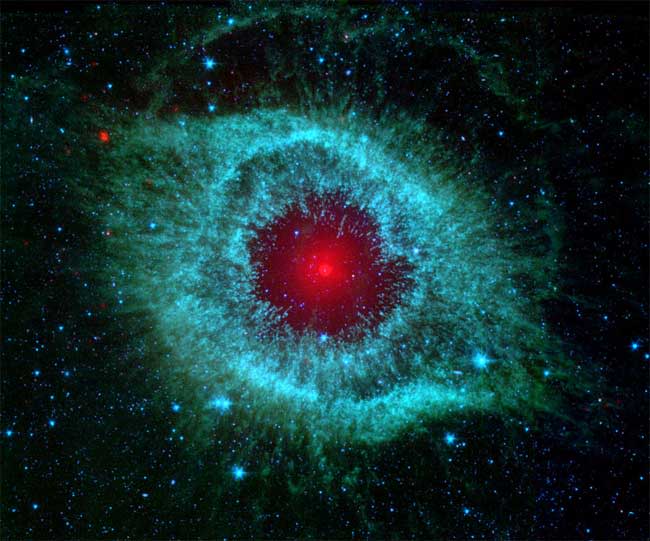Astronomers may have solved the mystery of why the death shrouds of dead stars appear to lack sulfur, an element once known as “brimstone” and associated with the Biblical phrase “fire and brimstone.” According to theory, significant amounts of sulfur should be present in stellar debris fields throughout the universe.
So where did the sulfur go?
Astrophysicists from the Laboratory for Space Research (LSR) at the University of Hong Kong (HKU) have discovered why such fields of gaseous and dusty debris, or “planetary nebulae”, do not have the expected sulfur levels. Planetary nebulae are found around stars that have exhausted their nuclear fuel supplies and collapsed into dense stellar corpses called white dwarfs.
The team suggests that the expected sulfur content is not actually present at all, but instead performs a devilish trick, calling the element “devil’s gold” by those who mined it in solid form on Earth. In short, sulfur may be hiding in plain sight.
Planetary nebulae have an astonishing range of shapes and colors that fascinate professional and amateur astronomers alike. These nebulae provide short-lived “snapshots” of the deaths of stars, making them an important window into a star’s hydrogen-burning “main sequence” existence and leading to detailed studies of their chemical composition.
Relating to: James Webb Space Telescope makes rare detection of 2 exoplanets orbiting dead stars
Sulfur’s best trick ever pulled
Despite their somewhat confusing name, planetary nebulae actually have nothing to do with planets. Unlike protoplanetary disks, which are frisbees of matter around baby stars that collapse into natal planets, planetary nebulae form at the opposite end of a star’s life.
When stars exhaust the fuel supplies required for the nuclear fusion processes occurring in their cores, the energy pushing outward and protecting each core from the massive inward pull of the star’s own gravitational force also stops.
The stellar strife that has been balancing a star against collapse for billions of years is coming to an end, and gravity is the clear winner. Then, as the star’s core collapses, nuclear fusion still ongoing in the star’s fiery outer shell causes the star to swell.
This initially turns the star into a red giant star.
After about 5 billion years, the Sun will go through this process and swell, consuming the inner planets, including the Earth. As devastating and irreversibly altering as it is for planets orbiting near a dying star, the red giant phase is relatively brief. As a star’s outer layers cool and disperse further, they leave a smoldering stellar core, now a white dwarf, surrounded by a planetary nebula, its death shroud.
Planetary nebulae are also short-lived, but only remain coiled around white dwarfs for tens of thousands of years.
Returning to the missing sulfur puzzle, studies of planetary nebulae that revealed their chemical composition showed that they lack sulfur. But this is difficult to explain because sulfur must be produced in larger stars along with elements such as oxygen, neon, argon and chlorine. In fact, sulfur in planetary nebulae should be proportional to other elements.
However, this has not been observed especially around dead, intermediate-mass stars.

To solve the mystery of planetary nebula sulfur, the team looked at 130 planetary nebulae at the heart of the Milky Way, an unprecedented data set unpolluted by background noise or unwanted information.
The data set is attributed to the Very Large Telescope, one of the world’s most advanced optical telescopes, located at the Paranal Observatory in Chile’s Atacama Desert.
Chemical elements absorb and emit light at characteristic and unique wavelengths; This means that when light passes through a cloud of gas and dust, the elements within leave their fingerprints on that light, or “spectrum,” facilitating a research method called spectroscopy. What the team discovered in their data was that the lack of sulfur was a result of poor quality data on the light emitted from the planetary nebula.
RELATED STORY
— Fast-spinning white dwarf pulsar, the second pulsar we’ve discovered so far, sheds light on how stars evolve
— A massive ‘zombie’ star is hurtling away from its cluster
— Dead star at the heart of the cosmic graveyard predicts the sun’s fate
Using a large sample of the planetary nebula with a high signal-to-noise ratio, the researchers saw for the first time a strong “locking” behavior between sulfur and other elements, effectively eliminating the previous anomaly.
The team argues that these results show how important high-quality data is when dealing with scientific mysteries.
The team’s research was published in Astrophysical Journal Letters in January.